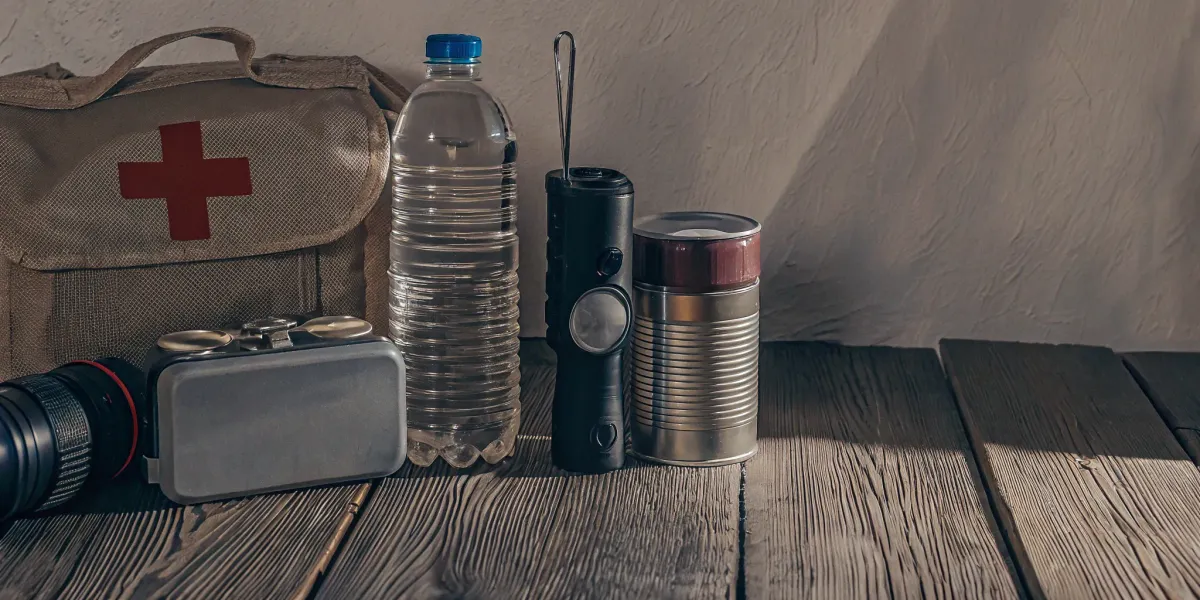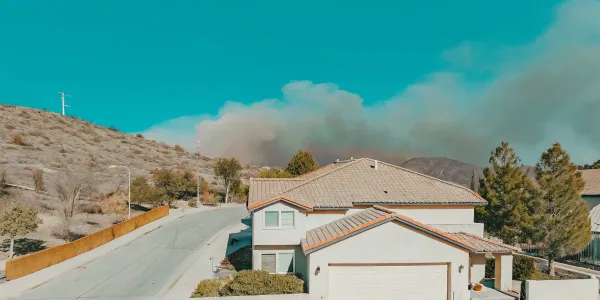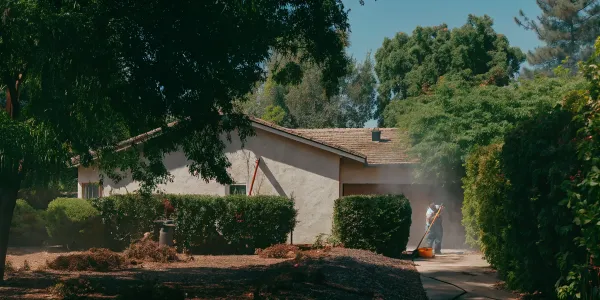Emergency Kit Items for Wildfire Preparedness: What to Pack
Get a clear checklist of emergency kit items for wildfire preparedness. Learn what to pack so your family stays safe, comfortable, and ready to evacuate.

A generic, store-bought emergency kit is a start, but it’s not a complete solution. Your family is unique, and your go-bag should be too. A truly effective kit accounts for the specific needs of everyone in your household, from young children and seniors to pets. It considers personal medical needs, important documents, and even the climate you live in. This is where real preparedness happens—in the details. This guide goes beyond the basic checklists to help you build a customized lifeline. We’ll cover the essential emergency kit items every bag needs, then show you how to personalize it for your family’s safety and comfort.
Key Takeaways
- Customize for your household: A generic kit won't cover everyone's needs. Pack specific supplies for kids, seniors, and pets, and include at least a seven-day supply of any essential medications to keep your entire family safe.
- Prioritize accessibility over everything: Your go-bag is useless if you can't reach it in a hurry. Store your main kit in an easy-to-access spot like a front closet and keep a secondary kit in your car in case you can't get home.
- Avoid the "set it and forget it" trap: Your kit requires regular maintenance to be effective. Schedule a check-in every six months to swap out expired food and medicine, test your gear, and update documents to ensure your supplies are ready when you are.
What to Pack in Your Go-Bag: The Essentials
When an evacuation order comes, you might only have minutes to leave. A "go-bag" is a pre-packed emergency kit that contains everything you and your family will need to survive for at least 72 hours. Having this bag ready means you can grab it and go without a second thought, ensuring your safety during a stressful and chaotic time. The goal is to pack smart, focusing on the essentials that will keep you safe, fed, and informed until you can return home or get to a shelter. Think of it as your lifeline in a bag.
Survival Basics
Start with the absolute fundamentals for survival. This includes a flashlight with extra batteries (or a hand-crank version), a battery-powered or hand-crank radio to stay updated on emergency broadcasts, and a whistle to signal for help. A multi-tool can be invaluable for a variety of small tasks. It’s also wise to pack N95 dust masks to protect your lungs from smoke and ash. A common mistake is simply buying gear without knowing how to use it. Take a few minutes to familiarize yourself with every item in your kit so you’re not fumbling with instructions during an actual emergency.
Food and Water
Dehydration is a serious risk during an emergency. The standard recommendation is to have at least one gallon of water per person per day, for both drinking and sanitation. For food, focus on non-perishable items that don’t require cooking or refrigeration. Think high-energy foods like protein bars, granola, dried fruit, and nuts. Canned goods like tuna, beans, or soup are also great options, but don't forget to pack a manual can opener. Aim for a three-day supply for every member of your household. This ensures you have the sustenance you need while you're away from home.
First Aid and Medications
Medical needs don’t stop during an emergency. Your go-bag must include a well-stocked first-aid kit to handle common injuries like cuts, burns, and sprains. Beyond that, pack a seven-day supply of any prescription medications for family members, as well as glasses or contact lenses. It’s also a good idea to include over-the-counter medicines like pain relievers, allergy medication, and antacids. Make a list of all medications, their dosages, and any allergies to keep with your supplies. This preparation can be critical if you need to seek medical attention while evacuated.
Essential Tools and Gear
Beyond the basics, a few extra tools can make a huge difference. Pack sturdy work gloves to protect your hands, along with some basic sanitation supplies like moist towelettes, garbage bags, and plastic ties. Local maps are also crucial, as cell service and GPS may be unreliable during a wildfire. Consider packing a portable charger or power bank for your cell phone. To be extra prepared, you should store an additional, smaller emergency supply kit in your vehicle. This redundancy ensures you have access to essentials even if you can't get back to your house.
Key Documents and Cash
In the rush to evacuate, you don’t want to be searching for critical paperwork. Gather important family documents such as copies of birth certificates, passports, social security cards, insurance policies, and deeds or titles. Store them in a waterproof, portable container or save digital copies on a password-protected USB drive. You should also include cash in small denominations, as ATMs and credit card machines may not be working. Finally, create a family communications plan that includes emergency contact information for relatives and a designated meeting place in case you get separated.
Customize Your Kit for Your Family
A generic emergency kit is a good start, but it won’t cover the specific needs of your household. True preparedness means creating a go-bag that works for everyone under your roof—from the youngest to the oldest, including your furry family members. Taking the time to personalize your kit ensures that in a stressful evacuation, you have exactly what you need to keep everyone safe, comfortable, and cared for. This is a crucial part of your overall wildfire action plan, turning a basic checklist into a reliable lifeline for your family when it matters most.
Items for Kids and Seniors
When you have children, your kit needs more than just the basics. Pack essential baby supplies like formula, bottles, diapers, and wipes. For toddlers and older kids, include snacks they’ll actually eat, a favorite small toy or book for comfort, and any necessary medications. For seniors or other adults with specific needs, think about mobility aids, spare glasses, hearing aid batteries, and any special dietary items. The goal is to reduce stress during an already difficult time, and having familiar, necessary items on hand makes a world of difference for the most vulnerable members of your family.
Special Medical Needs
If anyone in your household relies on medication, this part of your kit is non-negotiable. Pack at least a seven-day supply of all prescription and over-the-counter medications. Don't forget items like inhalers, EpiPens, blood sugar monitoring equipment, or other essential medical supplies. It’s also a smart idea to include a waterproof bag with a written list of all medications, dosages, prescribing doctor information, and pharmacy details. Having this information organized and ready to go can be critical if you are displaced for an extended period and need to manage medical needs away from home.
Don't Forget Your Pets
Your pets are family, and they need their own go-bag. Pack a few days' worth of their food and water, along with collapsible bowls. Include any medications they take, a copy of their vaccination records, and a current photo of you with your pet in case you get separated. A sturdy leash, harness, and a pet carrier are essential for safe transport. Adding a favorite toy or blanket can also help reduce their anxiety during an evacuation. The ASPCA recommends keeping this kit right next to yours so you can grab both without a second thought.
Prepping for Your Local Climate
Your environment dictates some of the most important items in your kit. For those of us in hot, dry areas like much of California, that means packing more water than you think you’ll need. Include sunscreen, hats, and lightweight, light-colored clothing to protect against sun exposure. Dust masks (like N95s) are also critical for protecting your lungs from smoke and ash. Think about the specific challenges your area faces during a wildfire event—like power outages—and consider adding a solar-powered phone charger or a battery-operated fan to your kit to stay connected and comfortable.
Seasonal Kit Updates
Preparedness isn’t a one-and-done task. Your family’s needs change, and so do the seasons. Get into the habit of reviewing your emergency kits at least twice a year. A good time to do this is when you change your clocks for daylight saving time. Check the expiration dates on all food, water, and medications, and swap them out as needed. Test your batteries and electronic gear. You should also update clothing for the current season, replacing a heavy jacket with a lightweight rain poncho, for example. This simple routine ensures your kit is always ready when you need it most.
Where (and How) to Store Your Kit
Building your emergency kit is a huge step, but where you keep it is just as critical. A perfectly packed go-bag is useless if you can’t get to it when you need it most. The right storage strategy ensures your supplies are safe, accessible, and ready the moment an evacuation order is issued. Think about your daily routines and the layout of your home to find a spot that makes sense for both sheltering in place and leaving in a hurry. A few smart choices now can make all the difference in a chaotic moment.
Choose the Right Spot
Your kit needs a permanent home where everyone in the family knows to find it. The ideal location is easy to access and on the way out of your house. A hall closet near the garage or front door is a great option. If you have a basement or a designated interior shelter room, that works too. The key is to avoid tucking it away in a hard-to-reach attic or a cluttered corner of the garage. You should be able to grab it and go without thinking twice, even in the dark or under stress. Make it part of your home's natural flow.
Pick the Best Container
How you store your items matters. You’ll want to use one or two easy-to-carry containers, like large duffel bags or sturdy plastic bins with handles. Duffel bags are portable and can be thrown over a shoulder, leaving your hands free. Bins are great for protecting items from water damage and can be stacked neatly in a closet or car. Whichever you choose, make sure it’s not too heavy for you to lift and carry to your vehicle. The goal is a quick, clean getaway, not a struggle with your own supplies.
Keep It Cool and Dry
To ensure your supplies last, store your kit in a cool, dry, and dark place. Garages and sheds can experience extreme temperature swings that can spoil food, degrade batteries, and reduce the effectiveness of medications. Canned goods should be kept in a stable environment to prevent them from spoiling. For boxed or dry foods like granola bars, it’s a good idea to place them in tightly sealed plastic or metal containers to protect them from pests and moisture. This simple step preserves the shelf life of your supplies so they’re safe to use when you need them.
Plan for Quick Access
When you’re in a rush, you won’t have time to dig through a disorganized bag. The best way to organize your kit is to think of it as a large bag filled with smaller, labeled bags. Use packing cubes or even large zip-top bags to group similar items together. Create a pouch for first aid, another for food, one for documents, and one for tools and communication gear. This modular approach lets you find exactly what you need in seconds without dumping everything out on the ground. It turns a bag of stuff into a functional, life-saving system.
Why You Might Need More Than One Kit
A wildfire can start while you’re at work or running errands, cutting off the route back to your house. That’s why it’s smart to have more than one kit. Keep your main go-bag at home, but also prepare a smaller emergency kit to store in your vehicle. According to CAL FIRE, having supplies in your car ensures you’re prepared even if you can’t get home. This car kit should include essentials like water, non-perishable food, a first-aid kit, and a phone charger. A small workplace kit with comfortable walking shoes and a water bottle is also a good idea.
Common Emergency Kit Mistakes to Avoid
Building an emergency kit is a critical step in preparing for a wildfire, but simply having one isn't enough. Many well-intentioned people make simple mistakes that can render their kits ineffective when they're needed most. A go-bag packed with expired food or stored in an inaccessible location won't do you much good when an evacuation order comes. The goal is to create a reliable resource you can count on in a high-stress situation.
Avoiding these common pitfalls is just as important as choosing the right supplies. It’s about shifting your mindset from a one-time task to an ongoing preparedness strategy. A well-maintained and thoughtfully planned kit provides peace of mind and genuine security. By understanding where others go wrong, you can ensure your family’s kit is ready for action, helping you face an emergency with confidence and control. Let’s walk through the most frequent missteps and how you can steer clear of them.
Forgetting to Keep an Inventory
One of the most common mistakes is assuming that having survival gear is enough—without actually knowing what’s in your kit or how to use it. In the chaos of an evacuation, you won’t have time to search for an instruction manual or realize you forgot to pack a can opener. Create a simple, laminated inventory list and tape it to the outside of your kit. Review it every six months. This practice not only reminds you what you have but also prompts you to familiarize yourself with each item, ensuring you can use that multi-tool or hand-crank radio effectively when it counts.
Storing It in the Wrong Place
Your emergency kit is useless if you can’t get to it quickly. Stashing it in a dusty attic or at the back of a cluttered garage could be a critical error. The American Red Cross advises storing your supplies in a bag that's easy to carry so you can grab it and go. Keep your primary go-bag in a consistent, accessible location, like a front hall closet or right by the garage door. If you have a multi-story home, consider keeping a smaller kit on each floor. The key is immediate access—your kit should be retrievable in seconds, not minutes.
The "Set It and Forget It" Trap
Preparedness is not a one-and-done activity. Many people make the mistake of buying a pre-assembled kit and assuming their work is finished. But food expires, batteries corrode, medications become outdated, and your family’s needs change over time. Treat your kit as a living document. Set a calendar reminder to review its contents every six months. This is your chance to swap out expired items, add new prescriptions, update clothing sizes for children, and ensure everything is still in working order. A little routine maintenance prevents your lifeline from becoming a liability.
Lacking a Communication Plan
A go-bag helps you survive, but a communication plan helps you reunite. In a wildfire, cell service can be unreliable, and family members may get separated. It's crucial to establish a family communications plan before disaster strikes. Designate a single out-of-state friend or relative as a central point of contact for everyone to check in with. You should also agree on two meeting spots: one just outside your home for a sudden emergency and another outside your neighborhood in case you can’t return to the area. Make sure everyone, including children, has these details memorized or written down in their go-bag.
Not Practicing with Your Family
A plan is only effective if everyone knows their role. You can have the most organized kit and a detailed communication strategy, but it won’t help if your family hasn’t practiced it. Take the time to walk through your plan together. The National Weather Service suggests you discuss where the kit is stored, what to do in different emergencies, and who is responsible for grabbing what—including pets. You don’t need to run a full-scale drill every week, but a quick annual walkthrough can build muscle memory and reduce panic. This ensures that when an alert comes, everyone can act decisively instead of freezing in confusion.
Keep Your Kit Ready: A Maintenance Plan
Building your emergency kit is a huge step, but it’s not a one-and-done task. Think of it as a living resource that needs a little attention to stay effective. Over time, food expires, batteries die, and your family’s needs change. A kit with spoiled food or a dead flashlight won’t do you much good when you need it most. Setting up a simple maintenance plan ensures that when an evacuation order comes, you can grab your go-bag with confidence, knowing everything inside is ready to go. It only takes a few minutes twice a year, but that small investment of time can make all the difference in an emergency.
Create a Rotation Schedule
The easiest way to stay on top of your kit is to put it on your calendar. Experts recommend you check your emergency kit at least once every six months. A good way to remember is to tie it to a recurring event, like when you change your clocks for daylight saving time. During this check-in, you’ll want to cycle out food and water, check expiration dates on medications, and make sure everything is still in good working order. This simple, twice-a-year habit prevents you from discovering that your supplies are unusable in the middle of a crisis.
Check Expiration Dates
Many items in your kit have a shelf life, including food, water, medications, and even batteries. It’s easy to lose track of these dates. A great tip is to write down the expiration dates for every perishable item and tape the list to the outside of your kit. This gives you an at-a-glance reference without having to dig through everything. When you do your six-month check, you can quickly see what needs to be replaced. Swap out any items that are nearing their expiration date and replace them with fresh supplies.
Test Your Gear Regularly
Imagine needing your flashlight during a power outage only to find the batteries are dead. That’s why it’s so important to regularly test your gear. During your scheduled maintenance, turn on your flashlights, battery-powered radios, and any other electronic devices to make sure they work. It’s also a good time to replace any supplies you may have used since your last check. According to the Mayo Clinic, keeping your first-aid kit stocked with fresh supplies is critical for it to be effective when you need it.
Update Your Inventory Annually
While you should check your kit twice a year, it’s a good idea to do a more thorough inventory review at least once a year. Family needs can change quickly. You might have a new baby, a child who has outgrown their clothes, or a family member with a new prescription. Ready.gov suggests reviewing your kit annually to ensure it still meets your family’s current needs. This is your chance to add or remove items to keep your kit relevant, personalized, and truly useful for everyone in your household.
Keep Documents Current
Your go-bag should contain copies of your most important documents, but these papers are only helpful if they’re up to date. Make sure your kit includes current copies of your driver’s licenses, passports, birth certificates, insurance policies, and property deeds. If you’ve recently renewed your home insurance or refinanced your mortgage, swap out the old documents for the new ones. Having a complete and current set of paperwork is a core part of a solid wildfire action plan and will be invaluable for recovery after a disaster.
Related Articles
- What to Put in a Wildfire Go Bag: The Ultimate Guide
- Wildfire Car Emergency Kit: The Ultimate Checklist
- How to Build an Emergency Kit for Wildfire
- How to Pack for a Wildfire Evacuation: A 5-Minute Guide
- How to Build a Wildfire Emergency Kit at Home
Frequently Asked Questions
How much food and water is enough for a go-bag? A good rule of thumb is to pack a three-day supply of non-perishable food and water for every person in your household. For water, this means one gallon per person, per day. It sounds like a lot, but this amount covers both drinking and basic sanitation. When choosing food, prioritize high-energy items that don't require cooking, like protein bars, nuts, and dried fruit, and don't forget a manual can opener for any canned goods.
What's the most common mistake people make with their emergency kits? The biggest mistake is treating it as a one-time task. Many people assemble a kit and then forget about it for years, leaving them with expired food, dead batteries, and outdated medications when an emergency hits. Your kit is a living resource that needs regular attention. A little maintenance ensures your lifeline is actually ready when you need to rely on it.
Is one go-bag at home enough, or should I have kits elsewhere? While your main kit should be at home, a wildfire won't wait for you to be there. It's smart to keep a smaller, more compact emergency kit in your car. This kit should have essentials like water, snacks, a first-aid kit, and a phone charger. This way, you're prepared even if an evacuation order is issued while you're at work or running errands and can't get back home.
Besides the basics, what are some important items people often forget to pack? People are great at remembering flashlights and first-aid supplies, but often forget the administrative side of a disaster. Be sure to include copies of critical documents like passports, birth certificates, and insurance policies in a waterproof bag. Also, pack cash in small bills, as power outages can make credit cards and ATMs useless. Finally, include a written copy of your family communication plan with key phone numbers and meeting spots.
How can I make sure my kit is always ready to go? The best way to keep your kit ready is to schedule a quick check-in twice a year. A great time to do this is when you change your clocks for daylight saving time. During this review, check the expiration dates on food, water, and medicine, and swap out anything that's getting old. Test your electronics and replace the batteries. This simple routine turns preparedness into a habit and gives you confidence that your kit will work when it matters most.




